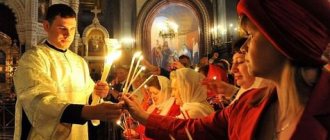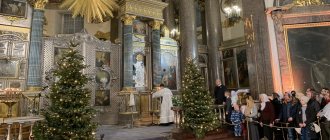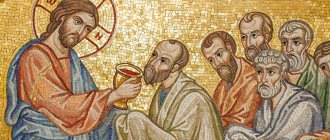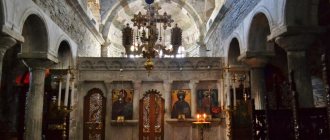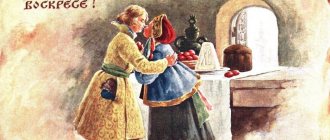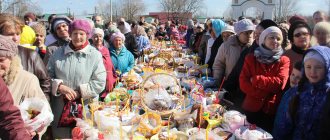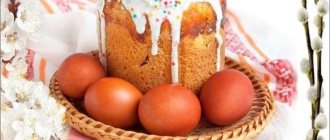Text of the Easter service download
Easter is approaching, and soon Orthodox Christians will greet each other with the joyful cry of “Christ is Risen.” Hegumen Silouan (Tumanov) talks about the features of the most joyful service of the year
***
Once a year, in the spring, when the earth sheds its snow cover and the air is filled with cool freshness and the chirping of birds that have finally decided to return to their homeland, many people, regardless of whether they go to church or pray at home, begin to excitedly ask: “When?!” “When will Easter be celebrated this year? Will we make it in time?!! Otherwise there is a lot of hassle. We must not lose face in the dirt and paint eggs and bake Easter cakes according to recipes that claim to strictly follow ancient traditions. And then celebrate as it should be: go to the cemetery to visit your relatives, cry at the grave, leave some vodka there with a crust of bread, and go home: set the table, drink some vodka again, but before that be sure to eat a blessed egg, otherwise it’s a sin!”
The week before Easter for the majority is spent in pleasant culinary chores, “so that everything is like people do,” and on the eve of Easter Sunday, lines of believers in their souls cross the church fence for the first time in a year and lay out their culinary masterpieces on the table, waiting for a noticeably tired priest with sprinkles and eyes , expecting something much more important than the consecration of Easter cakes.
The queue is long, while we wait for the priest, we will have time to talk with the neighbors. And here it becomes clear: the holiday does not end and is not limited to the blessing of food. The special holiday service begins at midnight and ends around three in the morning.
What is there to do in the temple for so long? Well, okay, the procession will go around the church with bells ringing - everyone knows that, but it will take about fifteen minutes. And what's next? And for what?
Interesting. If everyone goes, we will go too.
****
It is better to arrive early for the Easter night service. And think in advance about which temple. There will be people everywhere, but where there is a better choir or a central church that has been open for a long time, there will be more people.
It's best to bring... yourself. That is, your attention, your readiness for joy, your willingness not to be distracted by inconveniences and temptations in order to properly celebrate the Feast of Holidays and the Celebration of Celebrations.
The most correct thing, of course, is to confess the day before, so that you can then receive communion at the night Easter Liturgy of the Holy Mysteries of Christ. But, even if for some reason you were unable to prepare for Communion, just try to listen to what the Church offers us this night. After all, the Easter service is the most joyful event in the life of every believer. She is full of rejoicing in the Risen Christ. Listening to her words, penetrating into her meanings, we ourselves are filled with this great joy.
Games
The celebration of the Holy Resurrection of Christ included not only a solemn service in the church, but also public festivities. After many days of fasting and refusal of entertainment, the celebration took place widely - with round dances, games, and songs. Easter in Rus' was celebrated from 3 to 7 days, and in some regions - even until Trinity (celebrated 50 days after Easter).
A favorite Easter pastime was egg rolling, or “rolling.” Each region has its own rules of the game. For example, in the Pskov region, a player rolled a colored egg down an inclined wooden plank or a steep hill and tried to knock down other eggs standing below. If the participant achieved the goal, then he took the beaten egg for himself and continued the game. If he missed, the next one entered the game, and the unsuccessfully rolled egg remained. Wooden, skillfully painted eggs were often used; sometimes entire sets of such eggs were made especially for this entertainment. Rolling ball is still played in some regions.
Also at Easter they put up carousels and large swings; in the Pskov region they were called “zybki”. It was believed that the future harvest depended on swinging on them. That is why they swayed most often from Easter to Trinity, just during the active growth of wheat. There was also a belief that swings helped to find a husband or wife faster. In the Russian villages of the Udmurt Republic, this belief was preserved in Easter songs and ditties that were sung while swinging: “Red egg! / Tell the groom. / If you don’t say it - / We’ll swing you,” “There’s a swing on the mountain, / I’ll go swing.” / Today I’ll take the summer off, / I’ll get married in the winter,” “Let’s get married, let’s get married, / I’ll get married to myself.”
Swing song “Red Egg” performed by D.P. Dubovtseva and E.M. Barmina from the city of Izhevsk, Udmurt Republic
Among the popular ones was a game known as “toss the eagle” or “toss”. It was most often played for money. The simplest way to play: one of the participants tossed a coin, and when it fell to the ground, the second had to guess without looking which side it fell up. The obverse (heads) always meant a win, the reverse (tails) a loss. That's why the game got its name - "in the eagle." In some villages it has survived to this day, for example in the village of Kadyshevo, Ulyanovsk region.
Spring ritual processions with singing lyrical and round dances...
Pskov region
Easter game of “eagle” in Ulyanovsk Prisurye
Easter swinging and swing songs in Russian...
Easter Midnight Office
The festive service does not begin immediately at midnight from Saturday to Sunday, but a little earlier, a little later at 23.00.
We enter a darkened temple filled with people. Chandeliers - large chandeliers - are turned off. In front of the closed Royal Doors, on the pulpit there is a large stand in the form of a tomb. On it lies the Shroud - a decorated embroidered cloth with the image of Christ lying in the tomb.
A priest and a deacon in white robes quietly emerge from the altar and a special service begins - the floor at the altar, interspersed with the quiet singing of the choir. Its main part is the priest’s reading of the canon of Holy Saturday, which tells about the burial of Christ. At the end of the reading, incense is burned around the Shroud and, with the words “I will arise and be glorified,” the Shroud is brought into the altar through the open Royal Doors.
A few more prayers and the Midnight Office ends.
Silence again.
Procession
There are different traditions. Somewhere, Easter Matins begins exactly at midnight, and the religious procession that precedes it begins, accordingly, about 15 minutes before it. Somewhere at midnight the religious procession itself begins.
In any case, you can’t do without a religious procession.
Symbolizing the transition from the darkness of paganism to the light of Christianity, picturesquely shading the light of the Resurrection of Christ, the religious procession begins in a dark temple, illuminated only by candles burning in the hands of people.
If the abbot is familiar with Greek traditions, then he can bring the fire out for the parishioners from the altar while singing a special stichera: “Come, receive the light from the Never-Evening Light and glorify Christ risen from the dead!”
Photo of St. Petersburg Theological Academy
If there is no such tradition, then people light candles themselves.
So, after a short pause and lighting of candles, the clergy in the altar, with the gates and the curtain of the iconostasis closed, sing the stichera “Thy Resurrection, O Christ the Savior, the angels sing in heaven, and grant us on earth with a pure heart to glorify Thee” . At this time, three times censing is performed in the altar around the throne. We don’t see him, but we hear the clinking of the censer, and the scent of fragrant incense can be heard.
The stichera is sung louder each time, and the choir picks it up. The Royal Doors open, still in the dark, clergy in white robes, reminding us that in ancient times, right on the eve of Easter, everyone who wanted to become Christians was baptized, leaving the altar.
All the parishioners are already singing along with the choir. The jubilant ringing of bells is heard. Ahead of the priests are parishioners and altar servers who have prepared in advance, carrying a special lantern, followed by an altar cross, an altarpiece of the Mother of God. Next come in pairs the banner bearers, singers, candle bearers with candles, deacons with their candles and censers, and behind them the priests. In the last pair of priests, the one on the right carries the Gospel, and the one on the left carries the icon of the Resurrection. The procession is completed by the rector of the temple with the Easter tricandle and the Cross in his left hand.
If there is only one priest in the church, then the icons of the Resurrection of Christ and the Gospel are carried by the laity, covering their hands with scarves out of reverence for the shrine.
We follow the priests and we are all parishioners. We slowly walk around the temple. The soul rings inside in time with the bells, the lips sing holy and mysterious words, and the hands carefully cover the candle flame from the cool night spring breeze.
Everyone approaches the entrance to the temple, he calls the porch. The entrance, western doors are already specially closed.
Those who carry shrines stop near the doors, facing west. The ringing stops. The rector of the temple, having accepted the censer from the deacon, burns incense and glorifies the Holy Trinity.
The clergy sing three times the main hymn of the holiday - the troparion of Easter: “Christ is risen from the dead, trampling down death by death and giving life to those in the tombs (i.e. Christ rose from the dead, having conquered death by His death, and giving life to those in the graves) . ” The choir echoes them.
Then the priests sing special verses. We will hear them at the beginning of each service and sometimes at other places of service. This is called the Easter beginning:
“May God rise again, and let His enemies be scattered. And let those who hate Him flee from His face. As smoke disappears, let them disappear as wax melts in the presence of fire. Thus, let sinners perish from the Face of God, and let righteous women rejoice. This day, which the Lord has made, we will rejoice and be glad on it ,” etc.
For each verse, the singers again sing the troparion “Christ is risen.”
From time to time the rector addresses everyone with the greeting: “Christ is risen!” In response, you need to answer as loudly as possible: “Truly he is risen!” Don't be afraid, don't be silent - this is a night of special joy.
The church doors open, and the procession enters the temple, just as the myrrh-bearing women once entered Jerusalem to announce to the disciples about the Resurrection of the Lord.
The temple is filled with the light of all lamps. The bright Easter Matins begins, that is, Matins that begins long before dawn.
Matins and Liturgy
Everyone entered the temple and stood in their places. The deacon pronounces the great litany, that is, many short petitions to God for our spiritual and physical needs, to which the choir sings “Lord, have mercy.” After the priest's exclamation, the choir begins to sing the Easter canon in eight parts, a composition by St. John of Damascus, who lived in the 9th century in Syria, is the crown of spiritual songs.
The choir sings, sometimes solemnly, sometimes quickly. At each song of the canon, incense is performed, clergy in robes of different colors with a cross and censer quickly walk around the entire church, filling it with the aroma of incense, and joyfully greet everyone with the words “Christ is Risen!” (Don’t forget to answer loudly “He is risen indeed!”) These numerous exits of the priests from the altar remind us of the frequent appearances of Christ to His disciples after the Resurrection.
“Photo of the St. Petersburg Theological Academy”
It is clear that some festive chaos is being created, people have to constantly crowd in order to let the priests through, while we try not to set each other on fire with the candles that we are still holding in our hands. So the text of the Easter canon becomes background noise and passes us by. In vain, of course.
The Easter Canon is an outstanding work of church literature. Lush, Byzantine-style, replete with beautiful figures of speech and comparisons, it introduces us to the spirit and meaning of the very holiday of the Resurrection of Christ, makes us fully experience and understand this event in our souls.
Here are excerpts of the canon translated into Russian:
Resurrection day! Let's shine people! Easter! The Lord's Easter! For from death to life and from earth to heaven, Christ our God, singing the song of victory, translated us.
Come, let us drink a new drink, not miraculously produced from a barren rock (as by Moses in the Old Testament), but a source of immortality flowing from the tomb by Christ, on whom (as on a solid foundation, a rock) we are established.
Yesterday I was buried with You, Christ, and with You, who has risen this day, I rise; I crucified with You yesterday: Glorify me with You, Savior, in Your Kingdom!
Your ancestor David danced in front of the ark (which in the Old Testament, like a shadow, reminded of You); and we, the holy people of God, seeing the fulfillment of prophecies, will rejoice with divine inspiration, for Christ has risen as almighty.
Christ, as a one-year-old lamb, (sacrificed in the Old Testament at Easter) is for us a good crown, (who completed the operation of the Old Testament), the Blessed One was voluntarily slaughtered for the remission of the sins of all, as a cleansing Passover, and again shone for us from the tomb as the beautiful Sun of truth.
We will stay awake from early morning and instead of fragrant oil we will bring singing to the Lord, and we will see Christ - the Sun of truth, radiating life to everyone.
We celebrate the mortification of death, the destruction of hell, the beginning of another - eternal - life, and in delight we glorify the culprit - the One blessed God of our fathers and the most glorified.
The canon ends with the solemnly sad singing of the exapostilary:
Having fallen asleep in the flesh as a mortal, You, the King and Lord, rose again on the third day, resurrecting Adam from corruption and abolishing death, the Easter of immortality, the salvation of the world.
And then the jubilant stichera of Easter sound:
“...Today the sacred Pascha has been revealed to us, the Pascha of the New Testament, the holy, the mysterious Pascha, the all-honorable Pascha, the Pascha of Christ the Redeemer, the immaculate Pascha, the great Pascha, the Pascha for the faithful, the Pascha that opens the doors of heaven to us, the Pascha that sanctifies all the faithful! ..."
At the end of Matins, after singing: “Let us embrace each other, shouting: brethren! and we will forgive all those who hate us through the resurrection,” believers greet each other, saying: “Christ is risen!” and answering “Truly he is risen!”, they kiss each other three times and exchange Easter eggs. This is called “being Christed.”
According to the Rule, the priests, having said Christ to each other at the altar, go out to the solea and here they say Christ with each of the parishioners. But in our time, with a large number of parishioners, the priest, coming out with a cross on the solea, shouting “Christ is Risen!” three times. signifies everyone with a cross on three sides, after which he returns to the altar.
The custom of greeting each other on Easter with these words is very ancient. Already the disciples of Christ “said that the Lord has truly risen” (Luke 24:34). In the words “Christ is Risen!” lies the whole essence of the Christian faith.
After the celebration of Christ, a special “Catechetical Word” of St. John Chrysostom, telling about the spiritual essence of the holiday:
“...enter, all of you, into the joy of your Lord! ... rich and poor, rejoice with each other; those who are abstinent and careless, honor this day equally; those who fasted and those who did not fast, rejoice now! The meal is plentiful, enjoy it all! A well-fed Taurus, let no one leave hungry! Everyone enjoy the feast of faith, everyone perceive the wealth of goodness!
Let no one weep over his misery, for the Kingdom has come for everyone! Let no one cry for their sins, because forgiveness has shined from the grave! Let no one be afraid of death, for Savior’s death freed us! Embraced by death, He extinguished death. Having descended into hell, He captured hell and grieved the one who touched His flesh.
Anticipating this, Isaiah exclaimed: “Hell was upset when it met You in its nether regions.” Hell is upset because it is abolished! I was upset because I was ridiculed! He was upset because he was killed! He was upset because he was deposed! I was upset because I was tied up! He took the body and touched God; accepted the earth, and found heaven in it; I took what I saw, but was subjected to what I did not expect!
Death! where is your sting?! Hell! where is your victory?!
Christ has risen and you have been cast down! Christ has risen and the demons have fallen! Christ has risen and the angels rejoice! Christ has risen and life triumphs! Christ is risen, and no one is dead even in the tomb! For Christ, having risen from the grave, was the first to rise from the dead (showing us the way). To Him be glory and His might forever and ever! Amen".
Several more hymns will be sung (in general there will be few readings that night) and the liturgy begins, during which you can hear the reading of the Gospel in different languages: in Slavic, Russian, as well as in the ancient languages to which the apostolic preaching extended - Greek, Latin, and in the languages of the peoples most known in the area.
At the end of the service, after communion, the most faithful and persistent parishioners who did not leave after the procession will consecrate special bread, reminiscent of a huge prosphora. He calls it Artos, which translated from ancient Greek means Bread. It will be worn at religious processions all week, cut and distributed to people a week later, on Saturday, as a large shrine.
And only then do we all go from the temple to the refectory - the temple, or home - and break our fast.
That's all for the night service. Here are three hours given as a sacrifice to God. Here it is, holy fatigue and a feeling of mystery and well-lived time.
By the way, if you did not hear and understand everything at the night service, you can pray in peace, without night fatigue, without thoughts about sleep and breaking the fast, at the same Easter services throughout Easter week - the week after Easter Sunday, morning and evening. And thereby complement the joy of night prayer. And nourish the soul with that blessed food that will strengthen us for the entire year remaining until next Easter.
Not the year that begins with the ringing of the chimes in January, but the liturgical year that begins with the ringing of Easter bells.
***
We know that time leads us to death.
But God made death itself not a dead end, but a gateway to another, eternal life. Therefore, we live in a special, church time, symbolically breaking the inexorable flow of time and letting eternity into it.
Eternity, to which the soul, excited by the clear mystery of the Resurrection, calls so much.
Eternity with God, whose Name we bear, and by Whom we sanctify all our paths on this Earth.
Eternity, which can become for each of us a genuine Easter, no longer requiring symbols, breaking the fast and rituals.
Easter of the end of suffering.
Easter consolation.
Easter of Life.
Public holidays and non-working days
All non-working holidays are listed in Article 112 of the Labor Code of the Russian Federation. There are 8 such dates in total, but there are more days for rest; in honor of the New Year holidays, Russia rests for 5 whole days. The full list of holiday non-working dates from this article looks like this:
- January 1-5 - New Year;
- January 7—Christmas;
- February 23 - Defender of the Fatherland Day;
- March 8—International Women's Day;
- May 1 - Spring and Labor Day;
- May 9 - Victory Day;
- June 12—Russia Day;
- November 4 is National Unity Day.
From this list it is obvious that additional days off for Easter are not officially provided for in Russia. This means that the norm of Article 112 of the Labor Code of the Russian Federation on transferring a day off that coincides with a holiday to another date does not apply. But the holiday itself always coincides with Sunday - a calendar day off, so there is no doubt how we will rest on Easter in 2022: on Saturday and Sunday.
But there are regions in which things are different; their authorities at the local level determine whether Easter is a day off or not every year.
ConsultantPlus experts examined whether it is necessary to charge double wages on Easter if the company’s personnel work on that day. Use these instructions for free.
